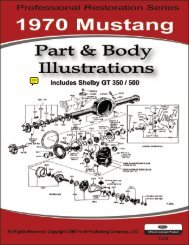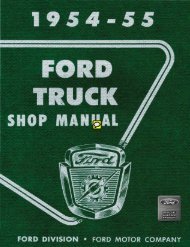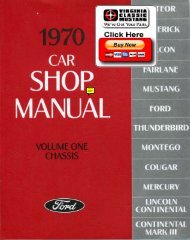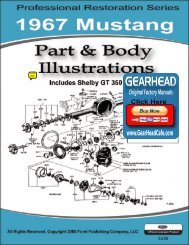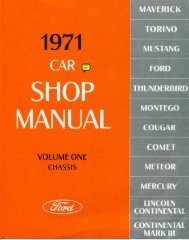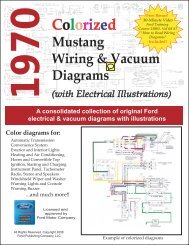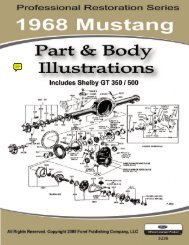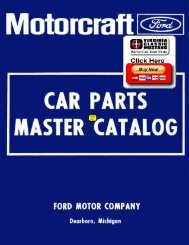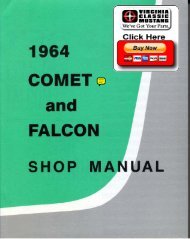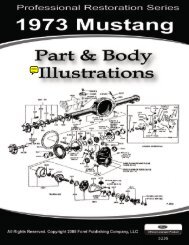DEMO - 1959 Ford Thunderbird Shop Manual - ForelPublishing.com
DEMO - 1959 Ford Thunderbird Shop Manual - ForelPublishing.com
DEMO - 1959 Ford Thunderbird Shop Manual - ForelPublishing.com
Create successful ePaper yourself
Turn your PDF publications into a flip-book with our unique Google optimized e-Paper software.
PART 1-1 -GENERAL ENGINE SERVICE 1-21<br />
the connecting<br />
CENTERLINE OF ENGINE<br />
A-AT RIGHT ANGLE<br />
TO CENTERLINE<br />
OF ENGINE<br />
B" PARALLEL TO<br />
CENTERLINE OF<br />
ENGINE<br />
1. OUT-OF-ROUND = DIFFERENCE BETWEEN A AND B<br />
2. TAPER = DIFFERENCE BETWEEN THE A MEASUREMENT AT TOP OF<br />
CYLINDER BORE AND THE A MEASUREMENT AT BOTTOM<br />
OF CYLINDER BORE<br />
FIG. 25 Cylinder Bore Out-Of-Round and Taper<br />
rod nuts to specifi<br />
cations. Do not turn the crankshaft<br />
while the Plastigage is in place.<br />
2. Remove the cap, then using<br />
the Plastigage scale check the width<br />
of the Plastigage.<br />
After the bearing clearance has<br />
been checked and found to be satis<br />
factory, apply a light coat of engine<br />
oil to the journal and bearings, then<br />
install the connecting<br />
rod cap.<br />
3. Repeat the procedure for the<br />
remaining connecting rods that re<br />
quire new bearings.<br />
FLYWHEELMANUAL-SHIFT<br />
TRANSMISSIONS<br />
INSPECTION<br />
Inspect the flywheel for cracks,<br />
heat check, or other defects that<br />
would make it unfit for further serv<br />
ice. Machine the friction surface of<br />
the flywheel if it is scored or worn.<br />
If it is necessary to remove more<br />
than 0.045 inch of stock from the<br />
original thickness, replace the fly<br />
wheel.<br />
Inspect the ring gear for worn,<br />
chipped, or cracked teeth. If the<br />
teeth are damaged, replace the ring<br />
gear.<br />
With the flywheel installed on the<br />
crankshaft, check the flywheel face<br />
runout.<br />
FLYWHEEL FACE RUNOUT<br />
Install a dial indicator so that the<br />
indicator point bears against the<br />
flywheel face (Fig. 24).<br />
flywheel making<br />
Turn the<br />
sure that it is full<br />
forward or rearward so that crank<br />
shaft end play<br />
as flywheel runout.<br />
1039-A<br />
will not be indicated<br />
If the runout exceeds the maxi<br />
mum limit, remove the flywheel and<br />
check for burrs between the fly<br />
wheel and the face of the crankshaft<br />
mounting<br />
flange. If no burrs exist,<br />
check the runout of the crankshaft<br />
mounting flange.<br />
wheel<br />
Replace the fly<br />
or machine the crankshaft<br />
flywheel face if the mounting flange<br />
runout is excessive.<br />
RING GEAR REPLACEMENT<br />
Heat the defective ring gear with<br />
a blow torch on the engine side of<br />
the gear, then knock it off the fly<br />
wheel. Do not hit the flywheel when<br />
removing the ring gear.<br />
Heat the new ring gear evenly<br />
until the gear expands enough to<br />
slip<br />
onto the flywheel. Make sure<br />
the gear is seated properly against<br />
the shoulder. Do not heat any por<br />
tion of the gear to a temperature<br />
higher than 500F. If this limit is<br />
exceeded, the temper will be re<br />
moved from the ring gear teeth.<br />
CYLINDER<br />
BLOCK<br />
During the disassembly<br />
of the<br />
cylinder block for engine overhaul,<br />
closely inspect the wear pattern on<br />
all parts to help diagnose the cause<br />
of wear.<br />
CLEANING AND INSPECTION<br />
Thoroughly<br />
clean the block in<br />
solvent. Remove old gasket material<br />
from all machined surfaces. Remove<br />
all pipe plugs which seal oil pas<br />
sages,<br />
then clean out all the pas<br />
sages.<br />
Blow out all passages, bolt<br />
holes, etc. with <strong>com</strong>pressed air.<br />
Make sure the threads in the cyl<br />
inder head bolt holes are clean. Dirt<br />
in<br />
the threads may cause binding<br />
and result in a false torque reading.<br />
Use a tap to true-up<br />
remove any deposits.<br />
threads and to<br />
After the block has been<br />
thoroughly cleaned, make a check<br />
for cracks. Minute cracks not visible<br />
to the naked eye may<br />
by coating<br />
be detected<br />
the suspected area with<br />
a mixture of 25% kerosene and 75%<br />
light motor oil. Wipe the part dry<br />
and immediately apply a coating of<br />
zinc oxide dissolved in wood alcohol.<br />
If cracks are present, the coating<br />
will be<strong>com</strong>e discolored at the de<br />
fective area. Replace the block if<br />
it is cracked.<br />
Check all<br />
machined gasket sur<br />
faces for burrs, nicks, scratches,<br />
and scores. Remove minor imperfec<br />
tions with an oil stone. Check the<br />
flatness of the cylinder block gasket<br />
surface following<br />
the procedure and<br />
specifications re<strong>com</strong>mended for the<br />
cylinder head.<br />
Replace all expansion-type plugs<br />
that show evidence of leakage.<br />
Inspect the cylinder walls for<br />
scoring, roughness, or other signs<br />
of wear. Check the cylinder bore for<br />
out-of-round and taper. Measure<br />
the bore with an accurate gauge<br />
following the instructions of the<br />
manufacturer. Measure the diam<br />
eter of each cylinder bore at the top,<br />
middle, and bottom with the gauge<br />
placed at right angles and parallel<br />
to the centerline of the engine (Fig.<br />
25).<br />
Refinish cylinders that are deeply<br />
scored and/or when out-of-round<br />
and/or taper exceed the wear limits.<br />
If the cylinder walls have minor<br />
surface imperfections, but the outof-round<br />
and taper are within limits,<br />
it may be possible to remove the<br />
imperfections by honing the cyl<br />
inder walls and installing<br />
new serv<br />
ice piston rings providing the piston<br />
clearance is within limits. Use the<br />
finest grade of<br />
honing stone for this<br />
operation.<br />
REFINISHING CYLINDER WALLS<br />
Honing is re<strong>com</strong>mended for re<br />
finishing cylinder walls only when<br />
the walls have minor imperfections,<br />
such as light scuffs, scratches, etc.<br />
The grade of hone to be used is<br />
determined by the amount of metal<br />
to be removed. Follow the instruc<br />
tions of the hone manufacturer. If




